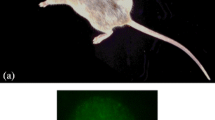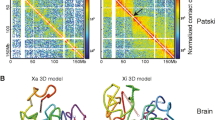Abstract
The paternal or maternal mammalian X chromosome is inactivated (‘lyonization’) at random early in the development of the female embryo1,2. Once established, the inactivation of the chromosome is maintained in the cell and in all its descendants. However, spontaneous local reactivation of the inactive X chromosome is found at low frequency in human–mouse hybrid cells3,4. So far only the Xg locus5,6 and the locus for microsomal steroid sulphatase (sts)7 (both assigned to the short arm of the X chromosome), have been shown to escape inactivation. The locus for hypoxanthine phosphoribosyltransferase (hprt) is susceptible to inactivation8 and humans heterozygous for HPRT deficiency (the Lesch–Nyhan syndrome, L–N)9, show a mosaic pattern of HPRT activity in their cultured fibroblasts8. To investigate the molecular basis of X inactivation, we have used DNA isolated from each of the two subpopulations of a L–N heterozygote, to transform cultured HPRT-deficient mouse fibroblasts. Transformation of the mouse cells with the inactivated human hprt+ gene occurred with essentially the same efficiency as with the active human hprt+ gene. Thus, reactivation of the lyonized human hprt locus is possible after interspecific DNA-mediated gene transfer.
Similar content being viewed by others
References
Lyon, M. F. Nature 190, 372–373 (1961).
Gartler, S. M. & Andina, R. J. Adv. hum. Genet. 7, 99–140 (1976).
Kahan, B. & DeMars, R. Proc. natn. Acad. Sci. U.S.A. 72, 1510–1514 (1975).
Hellkuhl, B. & Grzeschik, K.-H. Cytogenet. Cell Genet. 22, 527–530 (1978).
Race, R. R. & Sanger, R. Blood Groups in Man, 578–639 (Blackwell, London, 1975).
Fialkow, P. J. Am. J. hum. Genet. 22, 460–463 (1970).
Mohandas, T., Sparkes, R. S., Hellkuhl, B., Grzeschik, K.-H. & Shapiro, L. J. Proc. natn. Acad. Sci. U.S.A. 77, 6759–6763 (1980).
Rosenbloom, F. M., Kelley, W. N., Henderson, J. F. & Seegmiller, J. E. Lancet ii, 305–306 (1967).
Lesch, M. & Nyhan, W. L. Am. J. Med. 36, 561–570 (1964).
Gluzman, Y., Frisque, R. J. & Sambrook, J. Cold Spring Harb. Symp. quant. Biol. 44, 293–299 (1980).
Littlefield, J. W. Science 145, 709–710 (1964).
Kit, S., Dubbs, D. R., Piekarski, L. J. & Hsu, T. C. Expl Cell Res. 31, 297–312 (1963).
Graf, L. H. Jr, Urlaub, G. & Chasin, L. A. Somat. Cell Genet. 5, 1031–1044 (1979).
Meera Khan, P. Archs Biochem. Biophys. 145, 470–483 (1971).
Shin, S., Meera Khan, P. & Cook, P. R. Biochem. Genet. 5, 91–100 (1971).
Matsukuma, S., Zelle, B., Keijzer, W., Berends, F. & Bootsma, D. Expl Cell Res. 134, 103–112 (1981).
Fujimoto, W. Y. & Seegmiller, J. E. Proc. natn. Acad. Sci. U.S.A. 65, 577–584 (1970).
Ghangas, G. S. & Milman, G. Proc. natn. Acad. Sci. U.S.A. 72, 4147–4150 (1975).
Kahan, B. & DeMars, R. Somat. Cell Genet. 6, 309–323 (1980).
Mohandas, T., Sparkes, R. S. & Shapiro, L. J. Science 211, 393–396 (1981).
Wigler, M., Levy, D. & Perucho, M. Cell 24, 33–40 (1981).
Liskay, R. M. & Evans, R. J. Proc. natn. Acad. Sci. U.S.A. 77, 4895–4898 (1980).
Cook, P. R. Biol. Rev. 49, 51–84 (1974).
Brown, S. W. & Chandra, H. S. Proc. natn. Acad. Sci. U.S.A. 70, 195–199 (1973).
Davidson, E. H. & Britten, R. J. Science 204, 1052–1059 (1979).
Wigler, M., Pellicer, A., Silverstein, S. & Axel, R. Cell 14, 725–731 (1978).
Graham, F. L. & van der Eb, A. J. Virology 52, 456–467 (1973).
Miller, C. L. & Ruddle, F. H. Proc. natn. Acad. Sci. U.S.A. 75, 3346–3350 (1978).
Author information
Authors and Affiliations
Rights and permissions
About this article
Cite this article
de Jonge, A., Abrahams, P., Westerveld, A. et al. Expression of human hprt gene on the inactive X chromosome after DNA-mediated gene transfer. Nature 295, 624–626 (1982). https://doi.org/10.1038/295624a0
Received:
Accepted:
Issue Date:
DOI: https://doi.org/10.1038/295624a0
- Springer Nature Limited
This article is cited by
-
Cotransfer of syntenic human genes into mouse cells using isolated metaphase chromosomes or cellular DNA
Human Genetics (1985)
-
Comparison of transformation efficiency of human active and inactive X-chromosomal DNA
Nature (1983)
-
Transformation ofHprt gene with sperm DNA
Somatic Cell Genetics (1983)





